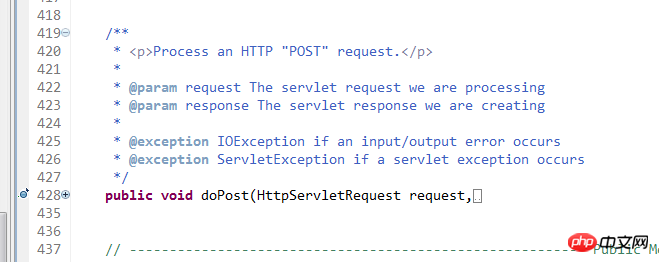這篇文章主要介紹了Struts1之url截取_動力節點Java學院整理的相關資料,需要的朋友可以參考下
##Struts1之url截取
#先我們來對ActionServlet深層進行分析。我們用斷點的調試的方式來看底層源碼。因為這個實例是post方式提交,所以將斷點設定到doPost方法。
我們debug運作程序,進入doPost裡面的方法:

## 重要是ActionServlet運作的核心方法。
我們進入這個方法:
##卷
# 我們赫然發現了這樣一個方法就是processPath方法,而這個方法就是要截取字串的方法。這個方法的原始碼如下:
/**
* <p>Identify and return the path component(from the request URI) that
* we will use to select an <code>ActionMapping</code> with which todispatch.
* If no such path can be identified,create an error response and return
* <code>null</code>.</p>
*
* @param request The servlet request weare processing
* @param response The servlet response weare creating
*
* @exception IOException if an input/outputerror occurs
*/
protectedString processPath(HttpServletRequest request,
HttpServletResponse response)
throws IOException {
String path = null;
// For prefix matching, match on the path info (if any)
path = (String) request.getAttribute(INCLUDE_PATH_INFO);
if (path == null) {
path = request.getPathInfo();
}
if ((path != null) && (path.length() > 0)) {
return (path);
}
// For extension matching, strip the module prefix and extension
path = (String) request.getAttribute(INCLUDE_SERVLET_PATH);
if (path == null) {
path = request.getServletPath();
}
String prefix = moduleConfig.getPrefix();
if (!path.startsWith(prefix)) {
String msg =getInternal().getMessage("processPath");
log.error(msg + " " + request.getRequestURI());
response.sendError(HttpServletResponse.SC_BAD_REQUEST, msg);
return null;
}
path = path.substring(prefix.length());
int slash = path.lastIndexOf("/");
int period = path.lastIndexOf(".");
if ((period >= 0) && (period >slash)) {
path = path.substring(0, period);
}
return (path);
}分析這段程式碼:
path = (String)request.getAttribute(INCLUDE_PATH_INFO);
if (path == null) {
path = request.getPathInfo();
}
if ((path != null) && (path.length() > 0)) {
return (path);
}這段程式碼首先判斷一下javax.servlet.include.path_info是否存在路徑訊息,這裡要知道當一個頁面是以RequestDispatcher.include方式顯示的話,這個屬性值才會存在。所以這裡沒有值,就會進入path=request.getPathInfo()程式中,這裡的getPathInfo所取得的值是相對servlet的路徑資訊。
// For extension matching, stripthe module prefix and extension
path = (String) request.getAttribute(INCLUDE_SERVLET_PATH);
if (path == null) {
path = request.getServletPath();
}
String prefix = moduleConfig.getPrefix();
if (!path.startsWith(prefix)) {
String msg =getInternal().getMessage("processPath");
log.error(msg + " " + request.getRequestURI());
response.sendError(HttpServletResponse.SC_BAD_REQUEST, msg);
return null;
}
path = path.substring(prefix.length());
intslash = path.lastIndexOf("/");
intperiod = path.lastIndexOf(".");
if((period >= 0) && (period > slash)) {
path = path.substring(0, period);
}
return (path);以上是關於Struts1之url截取的詳細介紹的詳細內容。更多資訊請關注PHP中文網其他相關文章!




